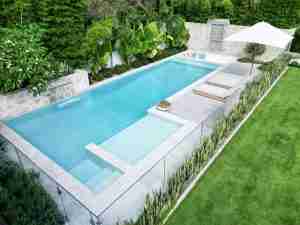Shipping container pools have become a popular trend in Australia. These unique and innovative pools offer an affordable and sustainable alternative to traditional pool options. If you’re considering investing in a shipping container pool, it’s essential to understand the costs involved. In this article, we will explore the various factors that influence the cost of shipping container pools, compare the costs to traditional pools, offer tips for reducing expenses, and discuss financing options.
Understanding Shipping Container Pools
Before we delve into the costs, let’s first understand what exactly a shipping container pool is. Essentially, it is a repurposed shipping container that has been transformed into a fully functional swimming pool. These pools provide a stylish and modern addition to any backyard, offering a contemporary and eco-friendly alternative to traditional pool designs.
What is a Shipping Container Pool?
A shipping container pool is a pool that is repurposed from a shipping container. These containers, typically used for transporting goods, are modified to include all the necessary features for a pool. They can be customized to suit individual preferences and come in various sizes and designs.
Benefits of Shipping Container Pools
There are several advantages to choosing a shipping container pool. Firstly, they are significantly more cost-effective compared to traditional pools. The materials and labor required for installation are considerably lower, resulting in overall savings. Additionally, shipping container pools are environmentally friendly, as they repurpose existing resources instead of requiring new construction materials. They can be easily transported, making them a versatile option for both urban and rural areas. Furthermore, these pools are known for their durability and longevity, ensuring that your investment lasts for years to come.
Factors Influencing the Cost of Shipping Container Pools
Several factors influence the cost of shipping container pools. Understanding these factors will help you determine a budget for your pool project.
Size and Design of the Pool
The size and design of the pool play a significant role in determining the cost. Larger pools require more materials, increasing the overall expenses. Similarly, intricate designs or custom shapes may require additional labor and expertise, resulting in higher costs. It’s important to carefully consider your requirements and consult with pool professionals to determine the most suitable size and design for your needs and budget.
Customization and Additional Features
The level of customization you desire for your shipping container pool will also affect the cost. Custom features such as built-in benches, waterfalls, or customized lighting can add to the overall expenses. It’s important to strike a balance between functionality and aesthetics while keeping your budget in mind.
Installation and Maintenance Costs
The installation and maintenance costs of a shipping container pool should be considered as well. The installation process involves site preparation, modification of the container, plumbing, and electrical work. These costs will vary depending on the complexity of the project and the existing infrastructure. Additionally, ongoing maintenance expenses such as cleaning, chemical treatment, and equipment maintenance should be factored into your budget.
Comparing Costs: Shipping Container Pools vs Traditional Pools
When considering the cost of a shipping container pool, it’s essential to compare it to the expenses associated with traditional pools. This will help you make an informed decision and determine if a shipping container pool is the right choice for you.
Initial Investment Comparison
Shipping container pools generally have a lower initial investment compared to traditional pools. Traditional pools involve the construction of a concrete or fiberglass structure, which can be quite expensive. In contrast, shipping container pools can be a more budget-friendly option, especially when considering the lower cost of materials and labor.
Long-term Cost Analysis
While the initial investment may favor shipping container pools, it’s crucial to consider the long-term costs. Traditional pools may have higher ongoing expenses in terms of maintenance, repairs, and water heating. Shipping container pools, on the other hand, require less maintenance and can be more energy-efficient. By carefully evaluating the long-term cost analysis, you can make an informed decision that aligns with your budget and needs.
Financing Your Shipping Container Pool
Once you have determined the cost of your shipping container pool, you may explore various financing options to fund your project.
Saving and Budgeting for Your Pool
If you prefer to save up for your shipping container pool, it’s essential to create a budget and start saving. By setting aside a fixed amount each month, you can gradually accumulate the necessary funds without incurring any interest or debt. This approach allows you to have full ownership of your pool without any financial obligations.
Financing Options for Shipping Container Pools
If saving up isn’t a viable option, you can consider financing options for your shipping container pool. Many financial institutions offer loans specifically tailored for home improvement projects. It’s important to compare interest rates, terms, and repayment options to find the most suitable financing solution for your circumstances.
Tips for Reducing Shipping Container Pool Costs
While shipping container pools offer a cost-effective swimming pool solution, there are further ways to reduce costs and stay within budget.
Choosing the Right Size and Design
Opting for a smaller pool size or a simpler design can significantly reduce costs. Consider your requirements and prioritize functionality over unnecessary features or extravagant sizes. By carefully selecting the size and design, you can strike a balance between your budget and desired pool aesthetics.
Opting for Minimal Customization
Custom features and additional accessories can quickly add to the cost of a shipping container pool. If budget is a concern, consider opting for minimal customization. Focus on the essential elements and add additional features at a later stage as your budget allows.
DIY Installation to Save on Costs
If you have the necessary skills and experience, you may explore the option of installing the pool yourself. DIY installation can significantly reduce labor costs. However, it’s crucial to ensure that you have the required permits and follow all safety guidelines to avoid any setbacks or additional expenses.
Conclusion
Shipping container pools offer an affordable and sustainable option for Australians seeking to enjoy the benefits of a swimming pool. By understanding the various factors influencing the costs, comparing them to traditional pools, considering financing options, and implementing cost-saving tips, you can embark on your shipping container pool journey with confidence. Whether you decide to go for a shipping container pool or a traditional pool, careful planning and budgeting will ensure a delightful swimming experience for you and your family.




